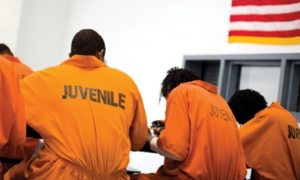Author(s): The National Law Center on Homelessness & Poverty and the National Network for Youth
Published: Feb. 13, 2019
Report Intro/Brief:
“Each year, an estimated 4.2 million youth and young adults experience homelessness, 700,000 of whom are minors who are not with a parent or guardian. These youth leave home for a variety of reasons, including severe family conflict, parental abuse or neglect, parental mental health issues, or substance abuse…
This report reviews the status of current law in 13 key issue areas that affect the lives and future prospects of unaccompanied youth experiencing homelessness in all 50 U.S. states and six territories (unless otherwise noted). The report offers an overview of the range of approaches taken by states since the last update in 2012 and the relative prevalence of these approaches, revealing significant differences from state to state.
The report also provides recommendations for policy changes in each of the areas, with a view towards strengthening the supports available to unaccompanied youth. While many issues surrounding unaccompanied youth remain controversial, the aim of this report is to recommend steps that can protect the safety, development, health and dignity of youth experiencing homelessness, and thus increase their prospects for positive future outcomes.
Key Findings
Many jurisdictions lag behind in implementing changes to federal law that strengthen access to education for youth experiencing homelessness.
- Only 14 jurisdictions (or 25%) have an updated dispute resolution procedure that
reflects changes made under the federal Every Student Succeeds Act. - None of these 14 explicitly protect the privacy rights of homeless students.
Definitions of unaccompanied youth often fail to be inclusive, developmentally appropriate, and non-judgmental.
- The vast majority of jurisdictions (48 jurisdictions or 85%) define 18 as the age at which a person is no longer a child.
- Only a few jurisdictions (7 or 13%) have a definition of “youth” that includes persons over 17 (usually 18-24) for purposes of determining who is eligible for critical supports and services.
- A few jurisdictions (8 or 14%) use words such as “incorrigible,” “unruly,” “delinquent,” “vagrant,” “wayward,” “undisciplined juveniles,” or “status offenders” when describing unaccompanied youth experiencing homelessness.
Punitive approaches to unaccompanied youth are prevalent in many jurisdictions.
- The vast majority of jurisdictions (44 or 79%) allow police to take unaccompanied youth into custody under Child In Need of Supervision, or similar, statutes.
- A small but significant number of jurisdictions define running away (9 or 16%) and truancy (6 or 11%) as status offenses.
- A significant number of jurisdictions (17 or 30%) explicitly make it a crime to “harbor,” i.e. to shelter or house—a youth who has run away regardless of the reasons for the young person leaving home.
Many jurisdictions authorize or require provision of health care, education, and other services to unaccompanied youth even in the absence of parental consent.
- A significant number of jurisdictions (22 or 39%) explicitly authorize provision of services to unaccompanied youth without court involvement.
- A majority of jurisdictions (36 or 64%) enable unaccompanied youth to apply for health insurance without parental consent in some situations.
- Half of jurisdictions (28 or 50%) allow minors to consent to mental health treatment.
- The vast majority of jurisdictions (45 or 80%) allow minors to consent to nonresidential substance abuse treatment.
- The vast majority of jurisdictions (53 or 95%) allow youth to consent to examination and treatment for sexually transmitted infections.
- The vast majority of jurisdictions (42 or 75%) limit minors’ ability to consent to abortions.
- The vast majority of jurisdictions (47 or 84%) allow exemption from the requirement that, in order to receive federal benefits, a minor parent must live with a parent or other legal guardian.
- Less than half of jurisdictions (25 or 44%) require procedures to address discharge or aftercare needs for youth exiting juvenile justice systems and of those, a few (10 or 18%) require that housing needs be addressed in such procedures.
- Nearly half of jurisdictions (25 or 45%) assign responsibility for providing services and/ or shelter to youth experiencing homelessness or who have run away to a designated executive branch agency; at least 9 or 16% of jurisdictions explicitly authorize the expenditure of funds, or authorize local units of government to expend funds, for programs and services targeted to such youth.
Most jurisdictions provide youth with some ability to act on their own behalf.
- A majority of jurisdictions (33 or 59%) have established processes for minors to petition for emancipation.
- Most jurisdictions (48 or 86%) have limited rights for minors to enter into contracts, but a few do not provide any contractual rights to minors.
Key Recommendations
Address barriers to obtaining valid government-issued photo identification and other documents often required to obtain supports and services.
- Reduce or eliminate fees for government-issued IDs and other vital records such as birth certificates and Social Security cards.
- Provide unaccompanied youth with alternative verification processes for proof of identity or residency.
- Eliminate “parental consent” requirements for unaccompanied youth to obtain government-issued IDs, birth certificates and Social Security cards.
Eliminate punishment of unaccompanied youth based on status.
- Limit the circumstances under which youth who have run away can be taken into custody or punished for running away; set very brief time limits for such custody when it is permitted; and prohibit sheltering of such youth with delinquent youth or adults.
- Provide opportunities for young people to avoid court involvement through: diversion and restorative justice programs, counseling, treatment, family mediation, housing assistance, and other services, as well as adequate time to meet treatment goals.
- Decriminalize running away, curfew violations, and truancy.
- Limit and prevent young people’s court involvement and their contact with the juvenile
and criminal justice systems. - Assign responsibility for the care and support of youth who have run away to the social service system rather than the juvenile justice system, and prohibit sheltering such youth in detention facilities.
Rather than punish youth, prioritize support and assistance.
- Establish clear eligibility for unaccompanied minors to apply for Medicaid and Children’s Health Insurance Program (CHIP); reduce barriers such as proof of parental income, a permanent address, and other documentation that unaccompanied youth may lack; and expand CHIP to include youth through 24 years of age.
- Establish a social service system to support youth after release from juvenile justice facilities and foster their reintegration, which should include safe housing options for youth who are not placed with a parent or guardian; and ensure their access to educational resources or job training, as appropriate.
- Before discharge from juvenile justice facilities, provide youth with assistance in obtaining a driver’s license or state ID card, a Social Security card, a birth certificate, and other records necessary to establish identity.
- Establish Temporary Assistance for Needy Families (TANF) eligibility for pregnant minors 120 days before their due date; and exempt them from the minor parent living arrangement rule where living with the parent is not safe, possible, or feasible. Provide assistance with childcare and transportation.
- Ensure access to education for unaccompanied youth, including those in and coming out of the juvenile justice system.
- Explicitly assign responsibility for offering opportunities and supports for youth who have run away from home and unaccompanied youth to a human services agency, and authorize and appropriate state and local funds for programs and services targeted to such youth.
Prioritize the educational needs of youth experiencing homelessness.
- Implement, and ensure that local education agencies and school districts implement, the Education for Homeless Children and Youth Program of the McKinney-Vento Homeless Assistance Act, as recently amended by the Every Student Succeeds Act. These amendments include ensuring that liaisons and state coordinators have the capacity to identify and remove barriers to the enrollment and retention of students experiencing homelessness, explicitly allowing partial and alternative academic credit accrual for youth experiencing homelessness, and promoting their access to higher education.
Extend eligibility for benefits and eliminate negative terminology.
- Extend eligibility for publicly-funded opportunities and supports available to children and youth to include older young people through age 24, and eliminate negative descriptions of youth experiencing homelessness now found in some statutes, such as “unruly,” “incorrigible, and “vagrant”.
Give youth authority to make important decisions about their own health and safety consistent with their maturity level.
- Establish emancipation procedures in all jurisdictions with individualized assessments of each youth’s ability to live independently, and permit young people to initiate the emancipation process; establish procedures for parents and youth to agree to emancipation without court involvement.
- Permit minors to contract for necessities, while providing appropriate protections.
- Establish statutory guidelines so licensed health care practitioners can provide medical care and services to an unaccompanied youth who consents if: (1) the medical practitioner reasonably believes that the youth understands the benefits and risks of the care and is giving informed consent; and (2) the care would be to the minor’s benefit; limit such practitioners from civil or criminal liability for providing care to unaccompanied youth in such circumstances.”
>>> CLICK HERE to see all of Youth Today’s REPORT LIBRARY






























